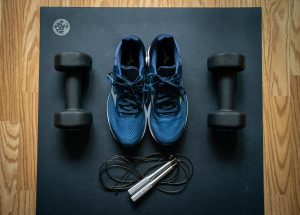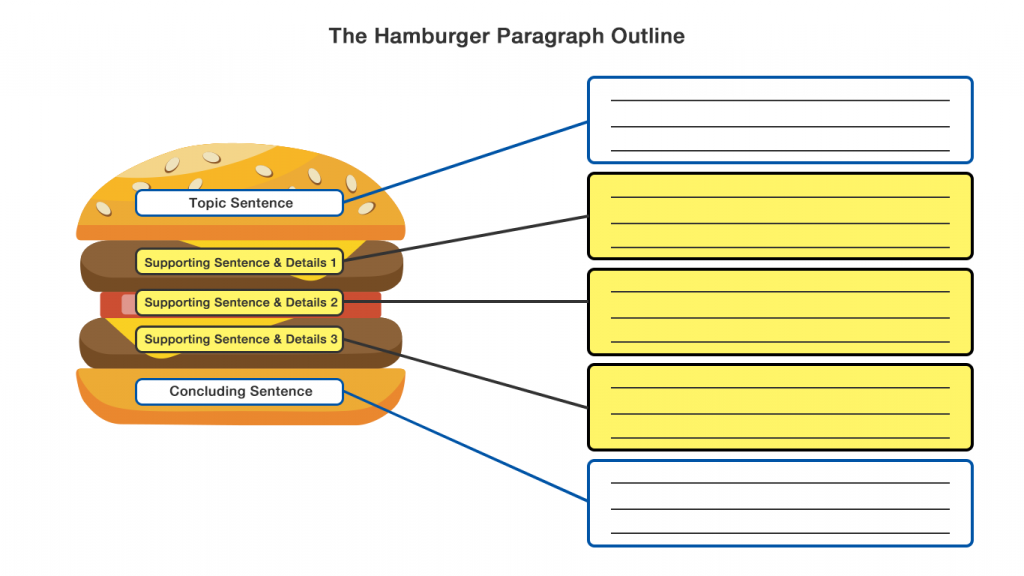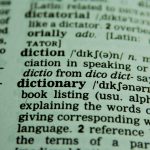Part Two Paragraph Writing Skills and Essay Introduction
Unit 4 Enumerative Paragraphs
Learning Objectives
- To understand what an enumerative paragraph focuses on
- To learn to write topic sentences, supporting sentences with details, conclusion, and transitions in enumerative paragraphs through multiple examples
- To apply the writing process to plan and write enumerative paragraphs
I. Warm-up

Read Paragraph “Public Laundromats in the U.S.A.” and do the activities that follow.
Public Laundromats in the U.S.A.
When I moved to Chicago, I was shocked because I had to use a public laundromat. Most people living in the apartments do not have their own washer and dryer, but I think this situation creates some problems for them. The transportation of dirty linen and clothes is the first problem. People need to collect everything and go down to the apartment basement where the machines are. Sometimes, they have to drive to the nearest laundromat if all washing machines are occupied by their neighbors. They may wait even half a day for a free washer or dryer. The second problem is having the exact change. Each washing costs $2.75 to $3.50. People need to frequently collect quarters or change money in the bank. The problems do not end here. The biggest problem of using public laundromats is hygiene. No one knows what kind of things people have washed in the same machines: underwear, linen, cloth diapers, even shoes. One day, while waiting for an available washer, I decided to take out a neighbor’s laundry from the washing machine because the laundry had been there for a long time. When I did this, I felt sorry and angry. I found different things which could not be washed together because it was not hygienic to do so. Of course, for eight months in America, I had to use the public laundromat more than a few times because I did not have another choice. Imagine my happiness and relief[1] when I finally bought my own first washing machine!
By E. Yugay (student), ESL Writing III, Harper College. Used with permission.
1. Color code the paragraph:
Title – pink Topic sentence – red Supporting sentences – green
Supporting details – blue Transitions – yellow Concluding sentence(s) – red
2. Discuss:
- Have you had similar experiences or witnessed similar situations as described in this paragraph?
- Does the writer focus on telling a story, arguing for a controversial[2] issue, or listing points to explain an idea?
- What types of supporting ideas and details are used to explain the main idea?
- Does the paragraph have unity?
- What information is included in the conclusion?
- Is the paragraph complete?
- Is the title centered on the topic line? Is the first sentence indented?
- What do you like about this paragraph?
- How would you improve the paragraph?
- If you could ask the writer a question, what would you ask?
II. Focus of Enumerative Paragraphs
To enumerate is to list or to count. It focuses on explaining some points to support a main idea. You have actually studied many enumerative paragraphs in Unit 2 and Unit 3, in addition to Paragraph “Public Laundromats in the U.S.A.” above.
- Unit 2 The Benefits of NSNT for Me
- Unit 3 Missing My Childhood Days
- Unit 3 Difficulties in English Writing
- Unit 3 My Special Place
- Unit 3 Good Roommates
- Unit 3 The Best Exercise
- Unit 3 Unleashed Dogs
- Unit 3 Three Benefits of Online Classes for College Students
Review those paragraphs for ideas, organization, language use, and format. In this unit, you are going to learn from more examples and to write your own enumerative paragraphs. Here are some more topics typical[3] of enumerative paragraphs:
- Communication barriers[4] among family members
- Characteristics of a good boss
- Benefits of owning a dog
- Reasons for coming to the U.S.
- Advice to new international students
III. Topic Sentence in Enumerative Paragraphs
For detailed explanations and examples of topic sentences, open Unit 3 here.
The same topic can produce many different topic sentences if the controlling idea is changed. Of course, the paragraph will be different as a result. This shows that you have the flexibility to decide on your focus based on your interests. Write from your heart!
Study the following topic sentences and discuss how writers focus on different areas of the same topic. You will notice that some topic sentences are more formal/academic in nature and some are more personal.
| Topics | Topic sentences with different controlling ideas |
|---|---|
| communication barriers among family members |
|
| characteristics of a good boss | |
| benefits of owning a dog |
|
| Reasons for coming to the U.S. |
|
Exercise 1. Try different controlling ideas and write at least two different topic sentences with each of the following topics.
Example:
Advice to new international students
Topic sentence 1: New international students will adapt to a new environment better if they prepare themselves well before leaving their native country.
Topic sentence 2: Finding a caring host family, working closely with professors and counsellors, and joining student clubs are the best ways for new international students to succeed.
- Ways to improve grades in this writing class
- Advantages of technology for elderly people
- Disadvantages of technology for young children
- The best kitchen appliance for you
- Your least favorite store
IV. Supporting Ideas in Enumerative Paragraphs
For detailed explanations and examples of supporting sentences, open Unit 3 here.
The Joy of Having My Three Children
It is a blessing that I have three children, aged 15, 11, and 6. First, they are not lonely anymore. When I had two children, they complained to me many times. My son wanted a younger brother, and my daughter wanted a baby sister. They also fought for toys. After my third child was born, their life changed a lot. Most times, they played with her and even taught her how to use chopsticks. Now all three children are very happy together. As a result, I am delighted. However, with three children, I feel really old sometimes, but they make me feel young. Each of my children has many activities, and I am very involved in their lives. Last month, when my second child participated in a cross-country competition[9] organized by the school district, I ran next to her and cheered her on. I felt young and energetic as if I were 16 years old again. The part I love the most is that they help me become a better person. Each child has a different personality. Sometimes, I cannot understand why they act in a certain way, but I find out that they are trying to imitate[10] my husband and me. “Children are mirrors of their parents”. This saying is so true. I can see my own problem through them because their action reflects my behavior. Now I am more careful when they are around. I do not yell, I do not judge other people, and I always say “Thank you”. I want to set a good example for them. Even though I am often physically tired, I love them because love makes miracles happen. My children are the joy of my life.
By D. Kim (student), ESL Writing III, Harper College. Used with permission.
Exercise 2. Use two of the topic sentences you have developed from Exercise 1 to make a paragraph outline for each. Check to see that the ideas support the topic sentence.
Example:
| Parts of a Paragraph | Outline Ideas |
|---|---|
| Topic sentence | Three subjects often cause disagreement between teenagers and their parents. |
| Question: | What are the three subjects? |
| Supporting Sentence 1 | about friends |
| Details 1 |
Teenagers: appearance, popularity; Parents: good students, good behavior |
| Supporting Sentence 2 | about free time |
| Details 2 |
Teenagers: games, movies, relaxing; Parents: reading, exercising, housework |
| Supporting Sentence 3 | about school work |
| Details 3 |
Teenagers: study not the only thing, favorite subjects; Parents: study, grades, college majors |
#1
| Parts of a Paragraph | Outline Ideas |
|---|---|
| Topic sentence | |
| Question: | |
| Supporting Sentence 1 | |
| Details 1 | |
| Supporting Sentence 2 | |
| Details 2 | |
| Supporting Sentence 3 | |
| Details 3 |
#2
| Parts of a Paragraph | Outline Ideas |
|---|---|
| Topic sentence | |
| Question: | |
| Supporting Sentence 1 | |
| Details 1 | |
| Supporting Sentence 2 | |
| Details 2 | |
| Supporting Sentence 3 | |
| Details 3 |
Exercise 3. Use Paragraph “The Joy of Having My Three Children” as an example. Add relevant information to make Paragraph “Ways to Reduce Stress” more interesting.
Ways to Reduce Stress

Modern life creates a lot of anxieties in people, but there are different ways to control stress. Physical exercises are a common solution. (Add some details here about how physical exercises help reduce stress.) Another idea is talking to a friend or family member. Someone says that sharing feelings and experiences with others is like releasing at least half the burdens. (Add some more details here about how talking helps reduce stress.) Besides working out and sharing, doing some chores will help relieve stress for some people. Many people do not like housework, but they do not know that household work may bring a sense of calm and normalcy. (Add some more details here about how doing chores helps reduce stress.) Stress has become an integral part of modern life. Isn’t it time for each person to find a way to handle it?
V. Conclusion in Enumerative Paragraphs
For detailed explanations and examples of concluding sentences, open Unit 3 here.
- Public Laundromats in the U.S.A.:
Of course, for eight months in America, I had to use the public laundromat more than a few times because I did not have another choice. Imagine my happiness and relief when I finally bought my own first washing machine!
- The Joy of Having My Three Children:
Even though I am often physically tired, I love them because love makes miracles happen. My children are the joy of my life.
Exercise 4. Read the following paragraph. Fill in the missing information as instructed.

Transportation in the Suburbs
(Start the paragraph with a topic sentence here.) To begin with, the buses run very infrequently[11]. Some buses come once an hour, even during the rush hours. If people miss the bus, they will have to wait for an hour for the next one. In that case, they will be late for their work or school. Additionally, it is not healthy to wait for a long time in winter. Winters can be very harsh, with heavy snow and biting winds. People can easily catch cold. The worst part is that the buses do not cover all the areas. (Add some details here about what inconveniences this situation may cause.) (Add a conclusion here to complete the paragraph.)
VI. More Enumerative Paragraph Examples
Read each of the paragraph examples below and do the following activities:
1. Color code the paragraph:
Title – pink Topic sentence – red Supporting sentences – green
Supporting details – blue Transitions – yellow Concluding sentence(s) – red
2. Discuss:
- Have you had similar experiences or witnessed similar situations as described in this paragraph?
- Does the writer focus on telling a story, arguing for a controversial issue, or listing points to explain an idea?
- What types of supporting ideas and details are used to explain the main idea?
- Does the paragraph have unity?
- What information is included in the conclusion?
- Is the paragraph complete?
- Is the title centered on the topic line? Is the first sentence indented?
- What do you like about this paragraph?
- How do you improve the paragraph?
- If the writer were here, what question would you ask him/her about the paragraph?
Click for each paragraph:
Exercise 5. Read the following paragraph. Is there a topic sentence? If not, add one. Is the paragraph unified? If not, cross out the irrelevant information. Can you add more interesting supporting details?

Winter Fun at Home
Winters in some areas of America are very cold. Many people have to stay indoors. The first interesting thing they can do is make home a fun zone. For example, they can set up a simple but comfortable home theatre with just a TV and a couch. A bag of popcorn and a cup of hot chocolate can add to a feeling of warmth and relaxation no matter how heavily it is snowing outside. A home theater like this is also fun in other seasons, so they can enjoy it year round. Second, they can make household chores into a competition, with prizes. For instance, they have a cleaning game every week. The older child will vacuum the carpet, the younger child will dust the furniture, and the parents will mow the lawn. They can rotate being the judge and deciding on the prizes. Children are usually happier to do housework when it is fun. Lastly, they can continue with physical activities at home. Gyms can be expensive, and people have to drive there. If they have a treadmill or stationary bike at home, that will be great. However, it is still fine without them. On the Internet, there are many training videos with no equipment needed, so everyone can choose what he or she likes to do including aerobics and tai chi. Winters can be long, but they do not have to be boring.
VII. Transitions in Enumerative Paragraphs
For detailed explanations and examples of transitions, open Unit 3 here.
You already know very well how to use transitions like “first, second, next, in addition, finally”. They are very useful expressions but not the only ones. Take a look at a variety of transitions used in the paragraphs in this unit. Notice the punctuation as well.
| Enumerative paragraphs in this unit |
Transitions between the supporting sentences and before the conclusion
|
|---|---|
| Public Laundromats in the USA
|
|
| The Joy of Having My Three Children |
|
| To Communicate or Not to Communicate? |
|
| My Favorite Hobby
|
|
| Writing Diary |
|
| Unforgettable High School Years
|
|
| Homesick for Spain
|
|
| The Inconveniences of Overseas Travels |
|
Exercise 6. The following paragraph is adapted from one in Unit 3. The transition before each supporting sentence is missing. Add an appropriate transition. The three supporting sentences are underlined, and you can combine each supporting idea with a transition. Try at least two transitions for each blank. Be careful with punctuation. The first one is an example.
Example:

__________(transition) The balcony has a beautiful lake view.
First, the balcony has a beautiful lake view.
The first reason I like the balcony is that it has a lake view.
My Special Place
Most people have their own special place in the house, and mine is my balcony. It is a wooden structure about 2 meters wide and 8 meters long. __________(transition) The balcony has a beautiful lake view. The balcony faces a small lake, and sometimes I see ducks swimming there. In the evening, the fountain in the middle of the lake lights up with soft music in the background. I always feel serene and mysterious with the night sky enveloping around me. __________ (transition) The balcony is a place where I rest after a day of hard study. No one bothers me there, and the noise from the house feels far away. My three young children often play in the living room, but they make an effort to play quietly when they see me in the balcony. They know it is “mommy time”. __________ (transition) It is a place where I reflect on my life. There are 2 pots of geranium flowers and 2 pots of cacti, a perfect harmony of pink and green, round and thorny, soft and spiky – just like life itself, I think about my life experiences while admiring the plants. I love my balcony!
VIII. Unit Review Practice: Writing Assignments
Now you are ready to write your own enumerative paragraph! As you have learned in Unit 2 The Writing Process (Open Unit 2 here), the best way to plan a paragraph is to follow the proper steps.
Enumerative Paragraph Writing Assignments
You will be writing two at-home enumerative paragraphs. The second one will start after the first one is complete. For both assignments, follow the instructions below.
Purpose: To show your understanding of planning and writing an enumerative paragraph. Use the writing process to help you.
Topic: Choose from the list below.
Brainstorm and Outline: Brainstorm for ideas. Then organize the ideas by using one the outline templates below. Your outline is due on _________. Bring it to class.
Paragraph: Your paragraph should have a title, a topic sentence, three supporting ideas with details, and a conclusion. Use proper transitions to connect ideas.
Format: Type your paragraph, double spaced, font size 12, with 1-inch margins on four sides of the page. Type your name, class, and date on the upper right-hand corner of the page. The first line of your paragraph should be indented. Save your paragraph in a Word file.
Self Checklist: When you finish writing, use the Self Checklist below. Put a checkmark beside each item if you think you did a good job in that area. Otherwise, improve your paragraph until you can check off the item. Save your work again.
Submission: Submit your paragraph on the Blackboard. Go to your Blackboard course site and follow the instructions there. Due by __________.
Choose one of the following topics. If you wish to write about a topic of your own, discuss with your professor first.
- What is the most significant change you have experienced in your life since you turned sixteen? Explain three reasons why it is so important. (not three changes)
- What are three advantages (or disadvantages) of Internet dating?
- What are three advantages (or disadvantages) of social media?
- What are the three reasons some people hold prejudices against some other people?
- What are the three difficulties ESL students (or you) have in reading?
- What are three good qualities of _____(a leader)? (Name a specific leader)
- What are the three words to describe your personality?
- What is an American custom you like very much? Explain three reasons why you like it. (Just one custom, not three)
- What is an American custom you do not like? Explain three reasons why you do not like it. (Just one custom, not three)
- What is one custom that you are the most proud of from your native country? What are the three reasons? (Just one custom, not three)
Enumerative Paragraph Outline Template #1
| Parts of a Paragraph | Outline Ideas |
|---|---|
| Topic sentence | |
| Question: | |
| Supporting Sentence 1 | |
| Details 1 | |
| Supporting Sentence 2 | |
| Details 2 | |
| Supporting Sentence 3 | |
| Details 3 |
Enumerative Paragraph Outline Template #2

Enumerative Paragraph Self Checklist
| Questions | Paragraph Revising and Editing Self Checklist | √ |
|---|---|---|
| 1 | Is my paragraph on topic and clear to understand? | |
| 2 | Is my paragraph interesting to read? | |
| 3 | Did I include a topic sentence with a clear controlling idea? | |
| 4 | Did I include 3 supporting ideas and connect them with transitions? | |
| 5 | Did I include a concluding sentence? | |
| 6 | Is my paragraph unified and complete? | |
| 7 | Did all my verbs agree with their subjects (subject-verb agreement)? Did I use proper verb tenses (verb tense shift)? | |
| 8 | Did I try my best to use correct sentence structure (simple, compound, complex)? | |
| 9 | Did I try my best to use correct grammar such as nouns, pronouns, and others? | |
| 10 | Did I try my best to have correct spelling, punctuation, and capitalization? | |
| 11 | Did I follow the proper paragraph format? |
Note: #7 – #10 may include more specific aspects of grammar depending on how many editing units you have already studied.
NSNT Practice

Go to The NSNT Free Writing Approach and Additional Weekly Prompts for Writing in Appendix A. (Open Appendix A here.) Choose two topics to write a paragraph each. You may start with the NSNT approach and then revise and edit the paragraphs using the Self Checklist above. You are encouraged to share your writing with your partner and help each other improve.
Vocabulary Review

The words here have appeared in this unit. The best way to learn them is to guess the meaning of each word from the context. Then hover your computer mouse over the number beside each word to check its meaning and part of speech. These words are also listed in the footnote area at the end of each unit.
Here, you can use the flashcards below to review these words.
Summary
- An enumerative paragraph focuses on explaining a few points (reasons, ways, approaches, aspects, etc.) to support a main idea.
- An enumerative paragraph should have a title, a topic sentence, 2-4 supporting ideas with details, a conclusion, and transitions.
- Following the writing process (pre-writing, writing, and post-writing) can ensure a well – organized and well – supported paragraph.
Media Attributions
- washing machines and dryers in a laundromat © Photo by Marshall Williams on Unsplash
- a red pencil writing the word “stress” © Photo by Pedro Figueras from Pexels
- a man waiting at a bus stop © Photo by MART PRODUCTION from Pexels
- athletic shoes, weights, jumping rope © Photo by Alexandra Tran on Unsplash
- a balcony with a table, two chairs, and some plants © Photo by Nguyen Dang Hoang Nhu on Unsplash
- hamburger paragraph © Chris Dobson is licensed under a CC0 (Creative Commons Zero) license
- a pen writing in a notebook © Photo by Aaron Burden on Unsplash
- a page in a dictionary © Pixabay
- relief: noun, a feeling when the worry disappeared ↵
- controversial: adjective, causing argument because of different opinions ↵
- typical: adjective, common, showing the nature of something ↵
- barrier: noun, a challenge or a difficulty that stops people from doing something ↵
- flexibility: noun, the quality of being willing to change ↵
- humility: noun, the quality of being humble, not proud ↵
- generosity: noun, the quality of being willing to give things to others or sharing things with others ↵
- prospect: noun, something about future ↵
- cross-country competition: noun phrase, a sport of running long and different paths ↵
- imitate: verb, follow or copy someone else's behavior ↵
- infrequently: adverb, not often ↵

